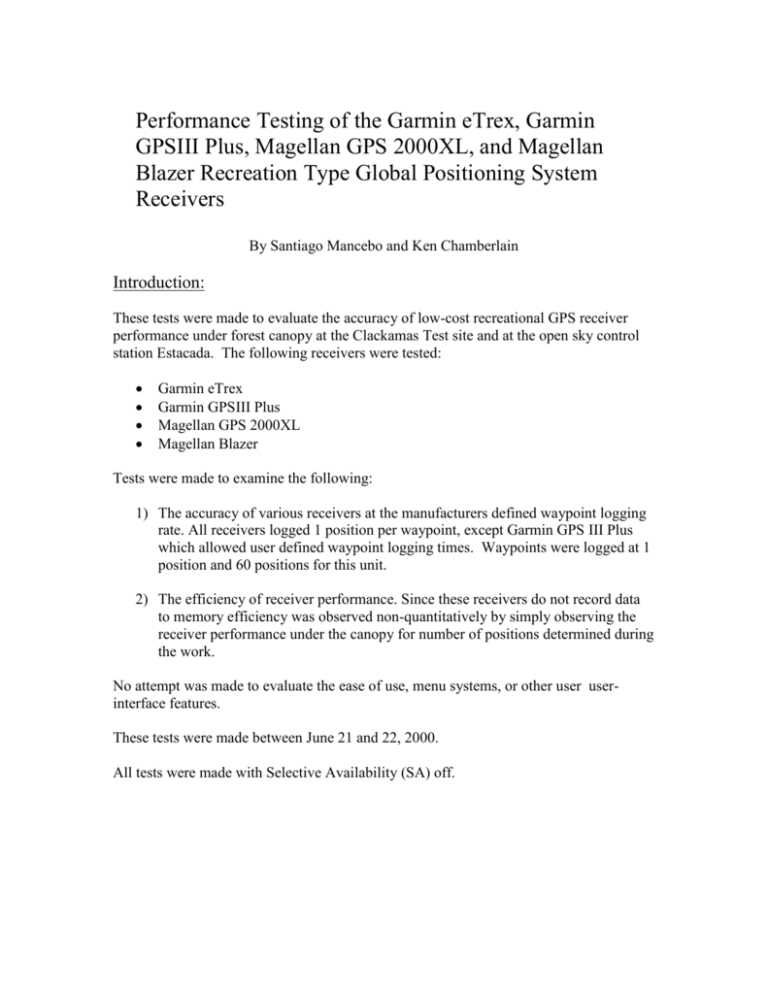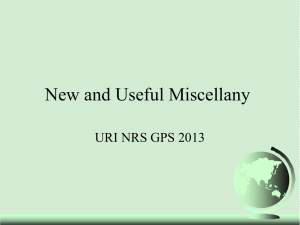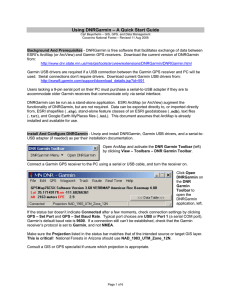nav_301
advertisement

Performance Testing of the Garmin eTrex, Garmin GPSIII Plus, Magellan GPS 2000XL, and Magellan Blazer Recreation Type Global Positioning System Receivers By Santiago Mancebo and Ken Chamberlain Introduction: These tests were made to evaluate the accuracy of low-cost recreational GPS receiver performance under forest canopy at the Clackamas Test site and at the open sky control station Estacada. The following receivers were tested: Garmin eTrex Garmin GPSIII Plus Magellan GPS 2000XL Magellan Blazer Tests were made to examine the following: 1) The accuracy of various receivers at the manufacturers defined waypoint logging rate. All receivers logged 1 position per waypoint, except Garmin GPS III Plus which allowed user defined waypoint logging times. Waypoints were logged at 1 position and 60 positions for this unit. 2) The efficiency of receiver performance. Since these receivers do not record data to memory efficiency was observed non-quantitatively by simply observing the receiver performance under the canopy for number of positions determined during the work. No attempt was made to evaluate the ease of use, menu systems, or other user userinterface features. These tests were made between June 21 and 22, 2000. All tests were made with Selective Availability (SA) off. Equipment: All the receivers tested have 12 parallel channels. Garmin eTrex: This is a very small, lightweight unit, field ruggedized with some armoring, and waterproof unit that stores 500 waypoints. Battery life is about 22 hours for 2 AA batteries. This receiver has PC communications with an optional data cable allowing uploading of waypoints. Weight is 6 ounces. Display is 64 x 128 characters. The cost of this unit is approximately $120. Garmin GPS III Plus: This is a small, lightweight, and waterproof unit that stores 500 waypoints. This is the only receiver tested with base map capability. It has a 4 color grayscale background map display and can store up to 1.44mg of Garmin format map data. No map other formats are supported these maps are on an optional CD at 100,000 scale, the cost is an additional $120. A data upload cable is supplied for uploading maps and waypoints. Display is 100 x 160 characters. Weight is 9 ounces. The cost of this unit is approximately $380. Magellan GPS 2000XL: This is a slightly larger unit which is waterproof, field ruggedized with wraparound rubber armoring, and scratch-proof display. The GPS 2000 XL receiver stores 200 waypoints. This unit offers NMEA data output for PC communication. The battery life is about 24 hours for 4 AA batteries. Weight is 10 ounces. Cost is approximately $150. Magellan Blazer 12: This is a small, lightweight, and waterproof unit that stores 100 waypoints. Battery life on this receiver is about 20 hours for 2 AA batteries. No NMEA data output. The Blazer 12 shares the same receiver and quadrifilar antenna with the other Magellan 300 series receivers; however the user interface menus, number of waypoint, the availably of NMEA ports, and many other features vary. The accuracy of other 300 series receivers should be similar to the Blazer. Weight is 6.8 ounces. The cost of the Blazer12 is approximately $110. No testing of the NMEA 0183 output to personal computers was made. Test Network and Survey Station Data: Forested Site: The Clackamas Test Network is located in Western Oregon on the Mt. Hood National Forest. Clackamas GPS Test Network is a site for testing P and C/A Code (resource grade) GPS receiver performance under moderate to heavy western Oregon timber canopy. The vegetation at the site consists of Douglas Fir and Western Hemlock over story, these trees are approximately 24-40" d.b.h., with a Vine Maple and Red Alder under story. The terrain at the site is nearly flat with no terrain obstructions above 20 degrees. The test network is composed of twelve points with known geographic positions. These twelve points were established by a conventional Total Station closed traverse survey which was based on two GPS points adjacent to the site which had reasonable satellite horizon. These two points were established by static carrier phase GPS survey connected to the Oregon High Accuracy Reference Network (HARN). Open Site: The station “Estacada” was used as a control site due to its clear-sky nature with no obstructions. Station “Estacada” is an Oregon High Accuracy Reference Network (HARN) Order A survey mark established by the National Geodetic Survey in 1998, PID-AI1994. The station is 487 KM, N 47 W of the Clackamas Test Network site. Field Data Logging Procedures: All GPS observations were made at approximate antenna height of 1.5 meters. Clackamas site: Waypoints were logged at 1 position per point for the 12 points in the Clackamas network this was repeated a second time for a total sample of 24 positions. For the Garmin GPS III Plus both 1 second and 60 second waypoints were logged. This was the only one of the receivers tested that allowed multiple positions to be averaged for waypoints. (see Figure 1: Garmin III Plus 60s). Estacada control point: Waypoints were logged at 1 position per point for 5 observations of the station Estacada. For the Garmin GPS III Plus both 1 second and 60 second waypoints were logged for the same 5 observations. Office Data Processing Procedures: The data analysis was made using Microsoft Office 2000 Excel spreadsheet application. All accuracies report at 2DRMS (see appendix 1 for formulas). The 2DRMS value closely approximates the 95% error for a position. In other words, 1 out of 20 measurements will have errors larger than those published in this report. All data was analyzed in the North American Datum of 1983 (NAD 83). SITE CONDITIONS: These tests were made under dry conditions. TEST RESULTS: Receiver Waypoint Accuracy 80 70 Meters 2dRMS 60 50 Place 40 Clackamas Estacada 30 20 10 0 Garmin etrex Garmin GPS III Plus Garmin GPS III Plus 60s Magellan 2000 XL Magellan blazer 12 Receivers Conclusions on Recreation GPS receivers: Accuracy performance in open sites is acceptable for mapping and GIS applications. A significant decrease in accuracy performance in forested sites was observed. Accuracy in forested sites is not acceptable for mapping and GIS applications. (see discussion of National Map Accuracy Standards below) The ability to log multiple observation waypoints offers increased accuracy for forested sites. The accuracy of the average of 60 positions made with the Garmin GPS III was not accurate enough for GIS applications at 31 meters. The efficiency observed for all receivers approached 100% even at forested sites. It appears that the PDOP and SNR settings for these receivers, which are not user configurable, are set to allow maximum data logging in adverse canopy conditions. These configurations allow “noisier” data to be logged therefore the high errors under canopy. The National Map Accuracy Standard (NMAS 1974) for point positions on 1:24,000 Scale Quadrangle maps is 12.2 meters at 90% or to put it in the same confidence interval as our study 14.8 meters at 95%. Therefore these receivers when used in open sites meet national map accuracy standards. When operating under tree canopy these receivers do not meet national map accuracy standards. Appendix A: Accuracy computation formulas used in this paper. Eei east i eT Eei northi nT Ehi Ee 2 i Eni2 2dRMS 2 RMS Appendix B : Receiver photos: (not to scale) Garmin GPS III Plus Garmin eTrex Magellan 2000XL Magellan Blazer 12









